Related Research Articles

Chen Daoming is a Chinese actor who has starred in various genres of film and television series.

King Zhou was the pejorative posthumous name given to Di Xin of Shang or King Shou of Shang, the last king of the Shang dynasty of ancient China. He is also called Zhou Xin. In Chinese, his name Zhòu also refers to a horse crupper, the part of a saddle or harness that is most likely to be soiled by the horse. It is not to be confused with the name of the succeeding dynasty, which has a different character and pronunciation.
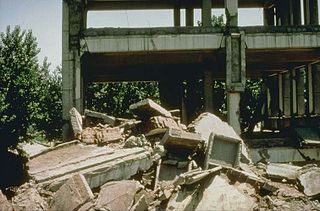
The 1976 Tangshan earthquake was a Mw 7.6 earthquake that hit the region around Tangshan, Hebei, China, at 3:42 a.m. on 28 July 1976. The maximum intensity of the earthquake was XI (Extreme) on the Mercalli scale. In minutes, 85 percent of the buildings in Tangshan collapsed or were rendered unusable, all services failed, and most of the highway and railway bridges collapsed or were seriously damaged. The official report claimed 242,769 deaths and 164,851 serious injuries in Tangshan, but when taken into account the missing, the injured who later died and the deaths in nearby Beijing and Tianjin, scholars accepted at least 300,000 died, making it one of the deadliest earthquakes in recorded history and worst disasters in China by death toll.
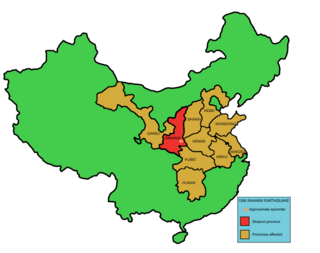
The 1556 Shaanxi earthquake, known in Chinese colloquially by its regnal year as the Jiajing Great Earthquake "嘉靖大地震" or officially by its epicenter as the Hua County Earthquake "华县地震", occurred in the early morning of 23 January 1556 in Huaxian, Shaanxi during the Ming dynasty.
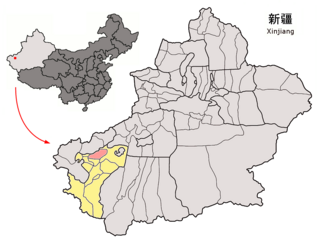
Payzawat County, also via SASM/GNC romanization as Payziwat County, and via Mandarin Chinese as Jiashi County is a county in Kashgar Prefecture, Xinjiang Uyghur Autonomous Region, China, on the western rim of the Taklamakan Desert. To the east, the county borders Maralbexi County, to the south Yopurga County.

Yutian County, also transliterated from Uyghur as Keriya County, is a county in Hotan Prefecture, Xinjiang Uyghur Autonomous Region, China. It is based at the Keriya Town, and is separate from Hotan County, which is another county in the same prefecture. The Yutian County has an area of 39,023 km2 (15,067 sq mi). According to the 2002 census, it has a population of 220,000. The county is bounded on the north by Aksu Prefecture, on the east by Minfeng/Niya County, on the west by Qira County and on the south by the Rutog and Gertse counties of the Tibet Autonomous Region.
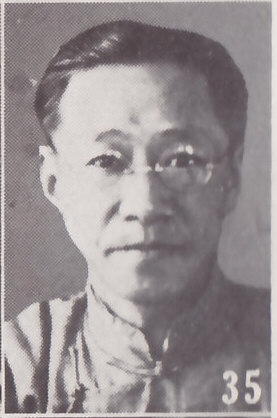
Weng Wenhao was a Chinese geologist and politician. He was one of the earliest modern Chinese geologists, and is regarded as the founder of modern Chinese geology and the father of modern Chinese oil industry. From May to November 1948, Weng served as President of the Executive Yuan (Premier) of the Republic of China.
Ling Zhang is a former senior audiologist and fiction writer in Toronto, Canada. She was born in Wenzhou, China and came to Canada in 1986 to pursue her MA in English at University of Calgary. She obtained her second MA degree in Communication disorders at the University of Cincinnati. She has published nine novels and several collections of novellas and short stories in Chinese. One of her novels,《金山》, has been translated into English, French, and German. She has won numerous important literary prizes in China.

The 1920 Haiyuan earthquake occurred on December 16 in Haiyuan County, Ningxia Province, Republic of China at 19:05:53. It was also called the 1920 Gansu earthquake because Ningxia was a part of Gansu Province when the earthquake occurred. It caused destruction in the Lijunbu-Haiyuan-Ganyanchi area and was assigned the maximum intensity on the Mercalli intensity scale. About 258,707~273,407 died, making it one of the most fatal earthquakes in China, in turn making it one of the worst disasters in China by death toll.
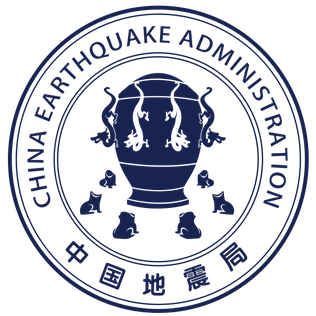
The China Earthquake Administration is a public institution managed by the State Council at the deputy ministerial level in charge of national earthquake disaster reduction work. It is currently managed by the Ministry of Emergency Management.
Qian Gang is a Chinese non-fiction writer and journalist from Hangzhou in Zhejiang Province, China who over four decades has written hundreds of articles and dozens of books.
The 1994 Taiwan Strait earthquake occurred on 16 September 1994, at 14:20 local time in the southern Taiwan Strait. The magnitude of this earthquake was given as Mw 6.8 by the USGS and Ms 7.3 by Fujian Seismological Bureau. The epicenter was located about 150 to 180 km from the coast of the border of Guangdong and Fujian, and about 150 km southwest of Taiwan.
The 25th Golden Eagle Awards were held September 21, 2010, in Changsha, Hunan province. Nominees and winners are listed below, winners are in bold.
The 1996 Baotou earthquake occurred on May 3, 1996, at 11:32 local time. The epicenter was located near Baotou, Inner Mongolia, China. It had a magnitude of Ms 6.4. The earthquake killed 26 people, injured 453, and left 196,633 homeless.
The National Outstanding Children's Literature Award is a major literary award in China, established in 1986. It is run by the China Writers Association, and is awarded every three years in the categories of novels, picture books, poetry, essays and non-fiction.
The Chen Bochui Children's Literature Award (陈伯吹儿童文学奖) is a major award issued in China, with the aim of promoting excellence in children's publishing and cultural diversity. It was originally called the Children's Literary Garden Prize (儿童文学园丁奖), then the Chen Bochui Children's Literature Award from 1988. The first awards were given in 1981, and were awarded every two years. It was renamed as the Chen Bochui International Children's Literature Award (陈伯吹国际儿童文学奖), and since 2014 has been held annually. It is named after the author, translator, journalist and educator Chen Bochui (1906-1997), who translated Pushkin’s Children’s Tales, The Wizard of Oz, and Don Quixote into Chinese for the first time in the 1940s, and who donated his life savings to establish this award. It is the longest continuously running literary prize in China.
References
- ↑ 徐岳仁; 何宏林; 李文巧; 张伟恒; 田勤俭 (2018). "1303 年洪洞地震宏观震中修订的新证据" [New evidences for amendment of macro-epicenter location of 1303AD Hongtong earthquake]. 地震地质. 40 (5): 948.
- ↑ China Earthquake Administration, ed. (2008). 地震知识百问百答 [100 Q&As on Earthquakes]. 地震出版社. Archived from the original on 2009-05-09.
实则直接死于地震的只有十数万人,其余70余万人均死于瘟疫和饥荒 [Actually, direct deaths from earthquake amount to 100,000-odd, the remaining 700,000-odd died from plagues and famine]
- ↑ 张思源 (2013). "1920年海原大地震死亡人数考析". 西夏研究 (1): 119.
- ↑ 王瓒玮 (2016-07-28). "唐山大地震四十年:反思与"记忆"". 东方历史评论. Reprinted as: 王瓒玮 (2016-07-28). "唐山大地震40年:从死亡人数到天灾还是人祸仍是一地鸡毛". Jiemian. Archived from the original on 2021-01-15. Retrieved 2019-02-06.
- ↑ 夏明方 (2020). "家庭的解体与重生:历史视野下的唐山大地震". 文明的“双相”——灾害与历史的缠绕. 广西师范大学出版社. p. 79.
- ↑ 曹树基 (2005). 大饥荒:1959-1961年的中国人口. Hong Kong: 時代國際出版. pp. 46, 67, 117, 150. ISBN 9789889828233. Archived from the original on 2016-02-11. An excerpt is published as: 曹树基 (2005). "1959-1961年中国的人口死亡及其成因". 中国人口科学 (1).
- ↑ 文贯中; 刘愿 (2010). "从退堂权的失而复得看"大跃进"饥荒的成因和教训" (PDF). 经济学(季刊). 9 (3): 1102.
- ↑ 刘仁团 (2001). "光绪大灾对北方人口的影响". In 曹树基 (ed.). 中国人口史 第5卷: 清时期. 复旦大学出版社. pp. 601, 677, 687–689.
- ↑ Li, Lillian M. (2007). Fighting Famine in North China: State, Market, and Environmental Decline, 1690s–1990s (PDF). Stanford: Stanford University Press. p. 304. Archived from the original (PDF) on 2021-12-27.
In Gansu the estimated mortality was 2.5 to 3 million in an already sparsely populated province of only 6 million people. In Shaanxi, out of a population of 13 million, an estimated 3 million died of hunger or disease
- ↑ 李文海. "光绪3年天津粥厂大火事件:保生粥厂不"保生"". 中国文化报. Archived from the original on 2021-12-16.
- ↑ "一九七七年 六十一团那场大火" [The great fire to the 61st Regiment in 1977]. Yili Evening News. 2007-02-26. p. B06. Archived from the original on 2021-01-09.
- ↑ 汤其成; 李秀云 (1995). "水圈中的自然灾害" [Natural disaster in the Hydrosphere]. In 王劲峰 (ed.). 中国自然灾害区划——灾害区划、影响评价、减灾对策. Beijing: 中国科学技术出版社. p. 41.
- ↑ "75·8板桥水库溃坝 20世纪最大人类技术灾难". Phoenix Television. 2012-09-03. Archived from the original on 2020-03-23.
- ↑ Courtney, Chris (2018). The Nature of Disaster in China The 1931 Yangzi River Flood. Cambridge University Press. pp. 249–250.